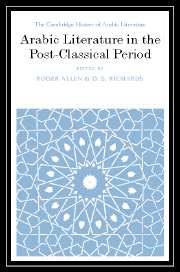Book contents
- Frontmatter
- The post-classical period: parameters and preliminaries
- Part I Elite Poetry
- Part II Elite prose
- 5 Pre-modern belletristic prose
- 6 The essay and debate (al-risāla and al-munāzara)
- 7 The maqāma
- 8 Mamluk history and historians
- 9 Historiography in arabic during the ottoman period
- Part III Popular poetry
- Part IV Popular prose
- Part V Drama
- Part VI Criticism
- Bibliography
- Index
- References
6 - The essay and debate (al-risāla and al-munāzara)
from Part II - Elite prose
Published online by Cambridge University Press: 28 March 2008
- Frontmatter
- The post-classical period: parameters and preliminaries
- Part I Elite Poetry
- Part II Elite prose
- 5 Pre-modern belletristic prose
- 6 The essay and debate (al-risāla and al-munāzara)
- 7 The maqāma
- 8 Mamluk history and historians
- 9 Historiography in arabic during the ottoman period
- Part III Popular poetry
- Part IV Popular prose
- Part V Drama
- Part VI Criticism
- Bibliography
- Index
- References
Summary
Risāla is a loosely used term in medieval Arabic literature. At its widest it merely refers to ‘a scroll which contains a small number of questions which belong to one kind’, as al-Jurjanī (d. 816/1413) defined it. In its general character, it resembles a kitāb or ‘book’, the main difference between the two being length, or, as al-Tahānawī (d. after 1158/1745) put it: ‘the difference between it and kitāb depends, as is commonly known, on completeness or deficiency, on addition or lack. A kitāb is a complete [exposition] of one discipline [fann] whereas a risāla is incomplete.’ Likewise, risālas often overlap with maqālas and both might be translated as essays; in fact, it is hard to see the difference between the various risālas and maqālas among, for example, al-Maqrīzī’s (d. 845/1442) works.
Risāla can thus, in the native tradition, be a short exposé of almost any field, and Hājjī Khalīfa (d. 1067/1657) shows how very wide the range of risālas was, both in earlier times and in the period under study here. One finds technical tractates of various kinds, scientific studies, Sufi manuals and brief discussions of various aspects of religious science, but also works belonging to belles-lettres. Risālas could roughly be divided according to a tripartite scheme into functional, technical and literary risālas, the first type being letters in the modern sense (conveying a message to the recipient), the second covering tracts or essays (brief studies of a limited subject) and the third consisting of various sub-genres that clearly fall within belles-lettres.
- Type
- Chapter
- Information
- Arabic Literature in the Post-Classical Period , pp. 134 - 144Publisher: Cambridge University PressPrint publication year: 2006
References
- 3
- Cited by



